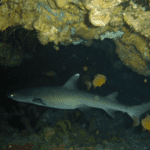Great Hammerhead sharks are an important shark variety with a unique set of teeth. Let us learn more about them.
The Great Hammerhead Sharks have triangular, small-shaped teeth that help them bite and crush their prey with ease. They can handle both soft-shelled and hard-shelled prey. The needle-like teeth of hammerheads are plenty in number and can help them chew through fishes and squids with ease.
There is a lot of speculation regarding the size, color, number, and types of hammerhead shark teeth. Let us look at some of the most commonly asked questions together.

Image Credits: “Georgia Aquarium – Hammerhead Shark” by hyku is licensed under CC BY 2.0
Do great hammerhead sharks have teeth?
Sharks need strong, sharp teeth that can help them fend for themselves. Let’s learn whether great hammerhead sharks have teeth.
Great hammerhead sharks have teeth, just like any other shark variety. As soon as these sharks are born, they swim into the ocean and are left to care for themselves. In the absence of any parental care, they need a full set of teeth to defend themselves against attacks and catch their own prey.
Sharks lose their teeth often as they are not attached to the root. However, they grow new ones quickly
How many teeth does a great hammerhead shark have?

Image Credits: “Hammerhead shark” by suneko is licensed under CC BY-SA 2.0
Sharks need a proper set of teeth to bite and chew their prey. Let’s learn more about how many teeth a great hammerhead shark has.
Great Hammerhead sharks have 17 rows of teeth on both sides of their upper jaw. On either side of their lower jaw, they have around 16-17 teeth. Besides, they have 3 teeth at the midline of the upper jaw and 1 to 3 teeth at the midline of the lower jaw. The number of teeth may vary at any given point.
The hammerhead sharks feed on fishes, octopuses, and other animals of the sea. Therefore, they need strong and sharp teeth that can cut through hard-shelled and soft-bodied prey.
Great Hammerhead shark tooth size
Another commonly asked question is what is the exact tooth size of Great Hammerhead sharks? Allow us to tell you more in this regard.
On average, Great Hammerhead sharks have teeth that range between ¼ to ¾ inches. Usually, the smallest shark teeth are ½ inches (1.2 cm), and the longest is no more than 7 inches (17.7 cm). The most commonly found shark teeth range from 3 ½ inches to 4 ½ inches. The largest known shark tooth measured 7 ⅜ inches.
Shark teeth that measure between 5 to 7 inches have become quite uncommon in modern species. There have been only a handful of instances of shark teeth growing beyond 7 inches.
Great Hammerhead shark tooth color
One of the most frequently asked questions about shark teeth pertains to its color. Let us learn what color teeth do Great Hammerheads have.
The Great Hammerhead sharks, like most other shark varieties, have white or cream-colored teeth. Since sharks lose their teeth often, the tooth sinks to the bottom of the ocean and gets buried under sediment. Here, the tooth undergoes the process of fossilization over time and acquires a dark hue.
Most shark teeth found around river beds and in sandpits are dark-colored because they have been fossilized. Sometimes, the color of the fossilized shark tooth may even be tan or beige.
Great Hammerhead shark tooth shape
A unique aspect of shark teeth is their varying shapes. Allow us to tell you more in this regard.
Great Hammerheads typically have triangular teeth. One interesting fact about their teeth set is that they are usually unserrated, and the shape varies along the jaw. Some hammerhead varieties (like the smooth hammerhead shark) have homodont teeth, which are all relatively smaller and of the same size.
Since hammerhead sharks primarily feed on fish, squid, and other animals, not having serrated teeth isn’t a disadvantage and their small, sharp, and smooth teeth help them bite and chew their prey better.
Great Hammerhead shark tooth type
Shark teeth are unique and of multiple types. Let us learn more about the Great Hammerhead shark tooth type.
The Great Hammerhead shark has typically triangular teeth made of calcium phosphate. It has smooth edges and deep grooves that help them hold on and bite on their prey. Their teeth are usually small but plenty in number which helps them effortlessly defend themselves against bigger sea animals and catch their prey.
In addition, their hammer-shaped heads help them see properly at a distance and sense potential prey quicker than other shark varieties.
Great Hammerhead shark tooth identification
Contrary to popular belief, it is not easy to identify shark teeth. Let us explore together how we can identify the Great Hammerhead shark tooth.
One of the best ways to identify Great Hammerhead shark teeth is by looking for small teeth that are not serrated. Besides, most shark teeth have a relatively glossy appearance and a distinct notch that makes identification easy. Shark teeth found on shores often darken over time and usually become black or gray.
Here, we must mention that sharks seldom have identical teeth, despite several similarities. So, it is possible to confuse hammerhead shark teeth with other shark varieties.
FAQs:
1. How many teeth does a Great Hammerhead Shark typically have?
Answer: A Great Hammerhead Shark usually has around 24 to 37 rows of teeth, with each row containing between 17 to 26 teeth. This adds up to a total of approximately 600 to 1,000 teeth in their mouth at any given time.
2. Can you describe the size and shape of a Great Hammerhead Shark’s teeth?
Answer: The teeth of a Great Hammerhead Shark are triangular, serrated, and curved. They are relatively small compared to the shark’s size, typically measuring around 1 inch (2.5 cm) in length. These teeth are well-suited for grasping and holding onto slippery prey.
3. How do Great Hammerhead Shark teeth differ from those of other shark species?
Answer: Great Hammerhead Shark teeth share some common characteristics with other shark species, such as their triangular shape and serrated edges. However, the specific arrangement and number of teeth can vary among different shark species.
4. Are there any interesting facts about the teeth of Great Hammerhead Sharks?
Answer: Great Hammerhead Sharks, like other sharks, have rows of teeth that are continually replaced throughout their lives. When a tooth is lost or worn down, it is quickly replaced by a new tooth from the rows of backup teeth.
5. What role do the teeth of Great Hammerhead Sharks play in their feeding habits?
Answer: The teeth of Great Hammerhead Sharks are adapted for capturing and holding onto their preferred prey, such as fish and rays. They use their teeth to grasp and swallow prey whole or in large chunks.
6. Can you provide some interesting facts about Great Hammerhead Sharks beyond their teeth?
Answer: Certainly! Great Hammerhead Sharks are the largest of all hammerhead shark species and are known for their distinctive hammer-shaped heads, which are thought to provide advantages in hunting and sensory perception. They are found in oceans around the world and are known for their solitary and migratory behavior.
7. Are Great Hammerhead Sharks considered a threat to humans due to their teeth?
Answer: Great Hammerhead Sharks are generally not considered a significant threat to humans. They are rarely involved in shark attacks on humans, and such encounters are extremely rare.
Conclusion
Hammerheads are beautiful, unique ocean animals that have distinct teeth set to make their lives in the deep ocean waters easier. Given its sharp edges and triangular shape, the teeth can help them bite into their food and crush it with ease. In combination with their broadheads, their teeth help them navigate the oceanic waters with ease and safety, defending themselves and finding proper feed.




